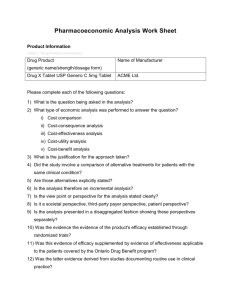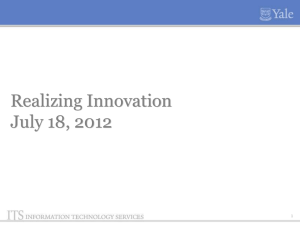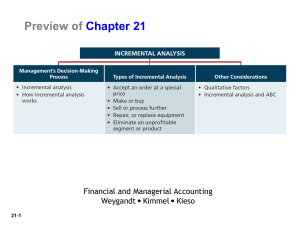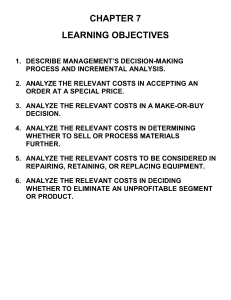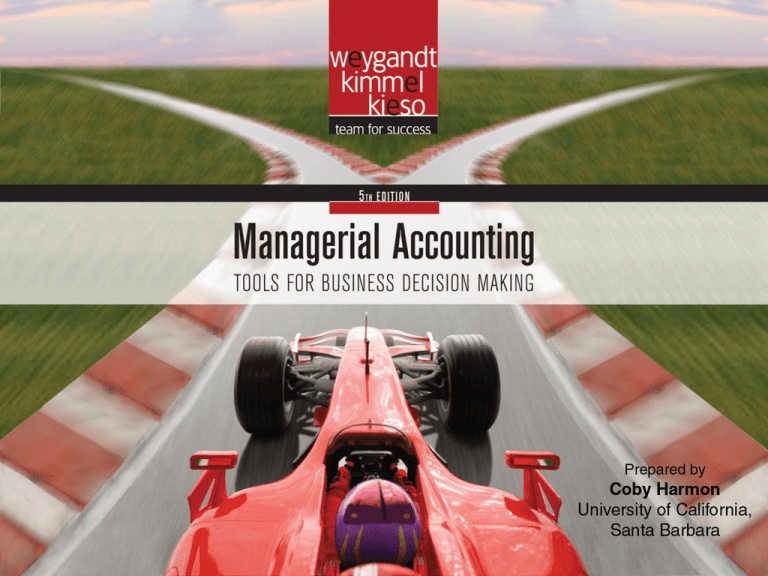
Page
7-1
Incremental Analysis
Managerial Accounting
Fifth Edition
Weygandt Kimmel Kieso
Page
7-2
study objectives
Page
7-3
1.
Identify the steps in management’s decision-making process.
2.
Describe the concept of incremental analysis.
3.
Identify the relevant costs in accepting an order at a special
price.
4.
Identify the relevant costs in a make-or-buy decision.
5.
Identify the relevant costs in determining whether to sell or
process materials further.
6.
Identify the relevant costs to be considered in retaining or
replacing equipment.
7.
Identify the relevant costs in deciding whether to eliminate an
unprofitable segment.
preview of chapter 7
Page
7-4
Management’s Decision-Making Process
Important management function.
Does not always follow a set pattern.
Decisions vary in scope, urgency, and importance.
Steps usually involved in process include:
Illustration 7-1
Page
7-5
SO 1 Identify the steps in management’s decision-making process.
Management’s Decision-Making Process
Considers both financial and non-financial
information.
Financial information includes revenues and
costs as well as their effect on overall
profitability.
Non-financial information includes effect on
employee turnover, the environment, or overall
company image.
Page
7-6
SO 1 Identify the steps in management’s decision-making process.
Management’s Decision-Making Process
Incremental Analysis Approach
Decisions involve a choice among alternative
actions.
Process used to identify the financial data that
change under alternative courses of action.
Both costs and revenues may vary or
Only revenues may vary or
Only costs may vary
Page
7-7
SO 2 Describe the concept of incremental analysis.
Management’s Decision-Making Process
How Incremental Analysis Works
Illustration 7-2
Comparison of Alternative B with Alternative A:
Page
7-8
Incremental revenue is $15,000 less under Alternative B.
Incremental cost savings of $20,000 is realized.
Alternative B produces $5,000 more net income.
SO 2 Describe the concept of incremental analysis.
Management’s Decision-Making Process
How Incremental Analysis Works
Important concepts used in incremental analysis:
Relevant cost.
Opportunity cost.
Sunk cost.
Page
7-9
SO 2 Describe the concept of incremental analysis.
Management’s Decision-Making Process
How Incremental Analysis Works
Sometimes involves changes that seem contrary to
intuition.
Variable costs sometimes do not change under
alternatives.
Fixed costs sometimes change between
alternatives.
Incremental analysis not the same as CVP analysis.
Page
7-10
SO 2 Describe the concept of incremental analysis.
Management’s Decision-Making Process
Review Question
Incremental analysis is the process of identifying the
financial data that
a. Do not change under alternative courses of
action.
b. Change under alternative courses of action.
c. Are mixed under alternative courses of
action.
d. None of the above.
Page
7-11
Solution on
notes page
SO 2 Describe the concept of incremental analysis.
Page
7-12
Types of Incremental Analysis
1. Accept an order at a special price.
2. Make or buy.
3. Sell or process further.
4. Retain or replace equipment.
5. Eliminate an unprofitable business segment.
6. Allocate limited resources.
Page
7-13
Types of Incremental Analysis
Accept an Order at a Special Price
Obtain additional business by making a major price
concession to a specific customer.
Assumes that sales of products in other markets
are not affected by special order.
Assumes that company is not operating at full
capacity.
Page
7-14
SO 3 Identify the relevant costs in accepting an order at a special price.
Types of Incremental Analysis
Accept an Order at a Special Price
Illustration: Sunbelt Company produces 100,000 automatic
blenders per month, which is 80 percent of plant capacity.
Variable manufacturing costs are $8 per unit. Fixed
manufacturing costs are $400,000, or $4 per unit. The
blenders are normally sold directly to retailers at $20 each.
Sunbelt has an offer from Mexico Co. (a foreign wholesaler) to
purchase an additional 2,000 blenders at $11 per unit.
Acceptance of the offer would not affect normal sales of the
product, and the additional units can be manufactured without
increasing plant capacity. What should management do?
Page
7-15
SO 3 Identify the relevant costs in accepting an order at a special price.
Types of Incremental Analysis
Accept an Order at a Special Price
Illustration 7-4
Fixed costs do not change since within existing capacity – thus
fixed costs are not relevant.
Variable manufacturing costs and expected revenues change –
thus both are relevant to the decision.
Solution on
notes page
Page
7-16
SO 3 Identify the relevant costs in accepting an order at a special price.
Types of Incremental Analysis
Make or Buy
Illustration: Baron Company incurs the following annual costs
in producing 25,000 ignition switches for motor scooters.
Illustration 7-5
Instead of making its own switches, Baron Company might
purchase the ignition switches at a price of $8 per unit. “What
should management do?”
Page
7-17
SO 4 Identify the relevant costs in a make-or-buy decision.
Types of Incremental Analysis
Make or Buy
Illustration 7-6
Total manufacturing cost is $1 higher than purchase price.
Must absorb at least $50,000 of fixed costs under either
option.
Solution on
notes page
Page
7-18
SO 4 Identify the relevant costs in a make-or-buy decision.
Types of Incremental Analysis
Make or Buy – Opportunity Cost
The potential benefit that may be obtained from
following an alternative course of action.
Page
7-19
SO 4 Identify the relevant costs in a make-or-buy decision.
Types of Incremental Analysis
Make or Buy – Opportunity Cost
Illustration: Assume that through buying the switches, Baron
Company can use the released productive capacity to generate
additional income of $28,000 from producing a different
product. This lost income is an additional cost of continuing to
make the switches in the make-or-buy decision.
Illustration 7-7
Page
7-20
Solution on
notes page
SO 4 Identify the relevant costs in a make-or-buy decision.
Types of Incremental Analysis
Review Question
In a make-or-buy decision, relevant costs are:
a. Manufacturing costs that will be saved.
b. The purchase price of the units.
c. Opportunity costs.
d. All of the above.
Page
7-21
Solution on
notes page
SO 4 Identify the relevant costs in a make-or-buy decision.
Page
7-22
Types of Incremental Analysis
Sell or Process Further
May have option to sell product at a given point in
production or to process further and sell at a
higher price.
Decision Rule:
Process further as long as the incremental
revenue from such processing exceeds the
incremental processing costs.
Page
7-23
SO 5 Identify the relevant costs in determining
whether to sell or process materials further.
Types of Incremental Analysis
Sell or Process Further - Single-Product Case
Illustration: Woodmasters Inc. makes tables. The cost to
manufacture an unfinished table is $35. The selling price per
Illustration 7-8
unfinished unit is $50.
Management concludes
that some of the
unused capacity may be
used to finish the tables and sell them at $60 per unit. For a
finished table, direct materials will increase $2 and direct labor
costs will increase $4. Variable manufacturing overhead costs
will increase by $2.40 (60% of direct labor). No increase is
anticipated in fixed manufacturing overhead.
Page
7-24
SO 5
Types of Incremental Analysis
Sell or Process Further - Single-Product Case
The incremental analysis on a per unit basis is as follows.
Illustration 7-9
Should Woodmasters sell or process further?
further.
Page
7-25
Solution on
notes page
SO 5 Identify the relevant costs in determining
whether to sell or process materials further.
Types of Incremental Analysis
Sell or Process Further - Multiple-Product Case
Joint product situation for Marais Creamery. Cream and skim
milk are products that result from the processing of raw milk.
Illustration 7-10
Page
7-26
Joint product costs are sunk costs and thus not relevant to the
sell-or-process further decision.
SO 5
Types of Incremental Analysis
Sell or Process Further - Multiple-Product Case
Cost and revenue data per day.
Page
7-27
Illustration 7-11
Determine whether the company should simply sell the cream
and skim milk, or process them further into cottage cheese
and condensed milk.
SO 5
Types of Incremental Analysis
Sell or Process Further - Multiple-Product Case
Analysis of whether to sell cream or process into cottage cheese.
Illustration 7-12
Marais should or should not process the cream further?
Page
7-28
Solution on
notes page
SO 5 Identify the relevant costs in determining
whether to sell or process materials further.
Types of Incremental Analysis
Sell or Process Further - Multiple-Product Case
Analysis of whether to sell skim milk or process into condensed
milk.
Illustration 7-13
Note the joint costs are irrelevant in deciding whether to sell
or process further.
Page
7-29
Solution on
notes page
SO 5 Identify the relevant costs in determining
whether to sell or process materials further.
Types of Incremental Analysis
Review Question
The decision rule is a sell-or-process-further
decision:
Process further as long as the incremental
revenue from processing exceeds:
a. Incremental processing costs.
b. Variable processing costs.
c. Fixed processing costs.
d. No correct answer is given.
Page
7-30
Solution on
notes page
SO 6 Identify the relevant costs to be considered
in retaining or replacing equipment.
Types of Incremental Analysis
Retain or Replace Equipment
Illustration: Jeffcoat Company is considering replacing a
factory machine with a new machine.
Assessment of replacement of factory machine:
Book Value
Cost
Remaining useful life
Salvage value
Old Machine
$ 40,000
four years
-0-
New Machine
$ 120,000
four years
-0-
Variable manufacturing costs decrease from $160,000 to
$125,000 if new machine purchased.
Page
7-31
SO 6 Identify the relevant costs to be considered
in retaining or replacing equipment.
Types of Incremental Analysis
Retain or Replace Equipment
Prepare the incremental analysis for the four-year period.
Illustration 7-14
Retain or Replace?
Page
7-32
Solution on
notes page
SO 6 Identify the relevant costs to be considered
in retaining or replacing equipment.
Types of Incremental Analysis
Retain or Replace Equipment
Additional Considerations
The book value of old machine does not affect the
decision.
Book value is a sunk cost.
Costs which cannot be changed by future decisions
(sunk cost) are not relevant in incremental analysis.
However, any trade-in allowance or cash disposal value
of the existing asset is relevant.
Page
7-33
SO 6 Identify the relevant costs to be considered
in retaining or replacing equipment.
Types of Incremental Analysis
Eliminate an Unprofitable Segment
Key: Focus on Relevant Costs.
Consider effect on related product lines.
Fixed costs allocated to the unprofitable segment
must be absorbed by the other segments.
Net income may decrease when an unprofitable
segment is eliminated.
Decision Rule: Retain the segment unless fixed costs
eliminated exceed contribution margin lost.
Page
7-34
SO 7 Identify the relevant costs in deciding whether
to eliminate an unprofitable segment.
Types of Incremental Analysis
Eliminate an Unprofitable Segment
Illustration: Martina Company manufactures three models
of tennis rackets:
Profitable lines: Pro and Master
Unprofitable line: Champ
Should Champ
be eliminated?
Illustration 7-15
Segment
income
data
Page
7-35
SO 7 Identify the relevant costs in deciding whether
to eliminate an unprofitable segment.
Types of Incremental Analysis
Eliminate an Unprofitable Segment
Prepare income data after eliminating Champ product line.
Assume fixed costs are allocated 2/3 to Pro and 1/3 to
Master.
Illustration 7-16
Total income is decreased by $10,000.
Page
7-36
Solution on
notes page
SO 7 Identify the relevant costs in deciding whether
to eliminate an unprofitable segment.
Types of Incremental Analysis
Eliminate an Unprofitable Segment
Incremental analysis of Champ provided the same results:
Do Not Eliminate Champ
Illustration 7-17
Page
7-37
SO 7 Identify the relevant costs in deciding whether
to eliminate an unprofitable segment.
Types of Incremental Analysis
Review Question
If an unprofitable segment is eliminated:
a.
Net income will always increase.
b. Variable expenses of the eliminated segment
will have to be absorbed by other segments.
c.
Fixed expenses allocated to the eliminated
segment will have to be absorbed by other
segments.
d. Net income will always decrease.
Page
7-38
Solution on
notes page
SO 7 Identify the relevant costs in deciding whether
to eliminate an unprofitable segment.
Other Considerations in Decision Making
Qualitative Factors
Potential effects of decision on existing employees
and the community.
Cost savings that may be obtained from outsourcing or
from eliminating a plant should be weighed against
these qualitative attributes.
Cost of lost morale that might result.
Page
7-39
SO 7 Identify the relevant costs in deciding whether
to eliminate an unprofitable segment.
Other Considerations in Decision Making
Relationship of Incremental Anaysis and
Activity-Based Costing
Many companies have shifted to activity-based costing
(ABC).
The primary reason for using ABC is that it results in
a more accurate allocation of overhead.
ABC will result in better identification of relevant
costs and, therefore, better incremental analysis.
Page
7-40
SO 7 Identify the relevant costs in deciding whether
to eliminate an unprofitable segment.
Page
7-41
Over a lifetime of work, high-school graduates earn an
average of $1.2 million, associate’s degree holders earn an
average of $1.6 million, and people with bachelor’s degrees
earn about $2.1 million.
A year of tuition at a public four-year college costs about
$8,655, and a year of tuition at a public two-year college
costs about $1,359.
Page
7-42
There has also been considerable research on other, lesstangible benefits of post–high-school education. For
example, some have suggested that there is a relationship
between higher education and good health. Research also
suggests that college-educated people are more optimistic.
About 600,000 students drop out of four-year colleges
each year.
Page
7-43
Each year many students decide to drop out of school. Many of
them never return. Suppose that you are working two jobs and
going to college and that you are not making ends meet. Your
grades are suffering due to your lack of available study time.
You feel depressed. Should you drop out of school?
YES: You can always go back to school. If your grades are bad,
and you are depressed, what good is school doing you anyway?
NO: Once you drop out, it is very hard to get enough momentum
to go back. Dropping out will dramatically reduce your long-term
opportunities. It is better to stay in school, even if you take only
one class per semester.
Page
7-44
Copyright
Copyright © 2010 John Wiley & Sons, Inc. All rights reserved.
Reproduction or translation of this work beyond that permitted
in Section 117 of the 1976 United States Copyright Act without
the express written permission of the copyright owner is
unlawful. Request for further information should be addressed
to the Permissions Department, John Wiley & Sons, Inc. The
purchaser may make back-up copies for his/her own use only
and not for distribution or resale. The Publisher assumes no
responsibility for errors, omissions, or damages, caused by the
use of these programs or from the use of the information
contained herein.
Page
7-45


